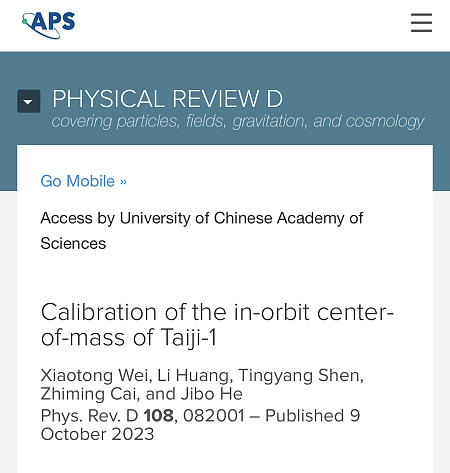
Einstein predicted the existence of gravitational waves in 1916, and the LIGO(Laser Interferometer Gravitational Wave Observatory)Collaboration announced the first direct detection of gravitational waves in human history on 11th February,2016 after a century’s exploration, which opens a new window to explore the universe. The detection of gravitational wave signals in the low and mid-frequency bands is needed in order to hear the motions of more massive objects. There are a lots of new gravitational waves sources in this band, which require the construction of space-based gravitational wave observatories. Taiji Program proposed by Chinese scientists is one of the space-based GW detection plans, which is proposed to launch three spacecrafts which will form an equilateral triangle in orbit around the Sun, with 3million kilometers length of each side, composing three sets of Michelson Interferometers.Taiji ProgramTaiji-1, as the technology verification satellite of the Taiji Program, was successfully launched on August 31, 2019, and has completed verification on key technologies, taking the first step towards China’s space-borne gravitational waves detection. The Gravity Reference Sensor (GRS), a main payload of the Taiji-1 satellite, is the endpoint and reference of the laser link of the future space-based gravitational wave detection satellite, to ensure that the test mass moves perfectly along the geodesic line, which is a prerequisite for the detection of gravitational wave signals. The inertial reference of the GRS is determined by the residual acceleration noise of its test mass, which means that the ambient noise need to be suppressed or subtracted.The calibration of the GW detection device’s core payload is a critical step in achieving the space-based GW detection. Recently, the research of calibration of the in-orbit center-of-mass of TaiJi-1 was published in Physical Review D [Phys. Rev. D 108 (2023) 082001]. Xiaotong Wei, a Ph.D. student of the class of 2020 at the International Center for Theoretical Physics-Asia-Pacific (ICTP-AP), is the first author and co-corresponding author of this paper, and his advisor, Prof. Jibo He, is the co-corresponding author as well. After calibration, the acceleration noise level of the gravitational reference sensor readout data in the medium-and-low-frequency band (0.001 to 0.1 Hz) was significantly reduced. The study was favorably reviewed by the referees of Physical Review D:“…Calibration of space-borne instruments is an important foundation for science…In general, the paper and the results are really good…”.This research was supported by the colleagues from the partner institutions of Taiji Alliance and the Strategic Priority Research Program of the Chinese Academy of Sciences (CAS)(XDA15020700, XDA15021100), as well as the Special Funds of the Fundamental Research Funds for Central Universities from the Ministry of Education of the People's Republic of China.Download the paper: https://doi.org/10.1103/PhysRevD.108.082001Center-of-mass calibration before (red dashed line) and after (blue) GRS triaxial readout of acceleration amplitude spectrum density